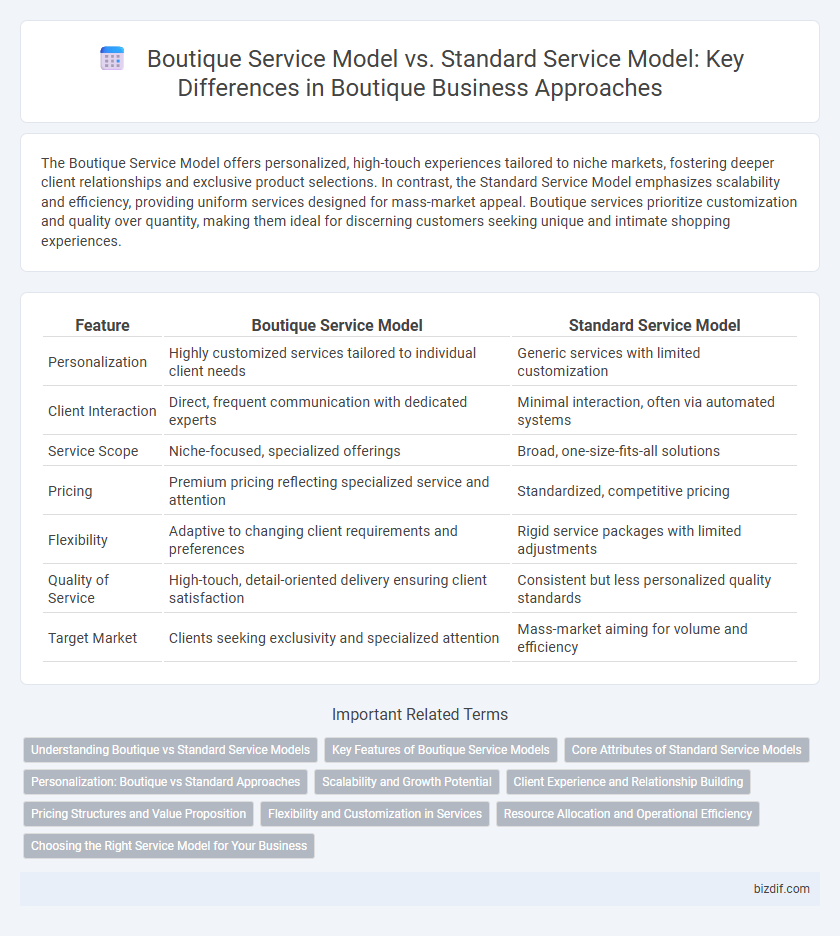The Boutique Service Model offers personalized, high-touch experiences tailored to niche markets, fostering deeper client relationships and exclusive product selections. In contrast, the Standard Service Model emphasizes scalability and efficiency, providing uniform services designed for mass-market appeal. Boutique services prioritize customization and quality over quantity, making them ideal for discerning customers seeking unique and intimate shopping experiences.
Table of Comparison
| Feature | Boutique Service Model | Standard Service Model |
|---|---|---|
| Personalization | Highly customized services tailored to individual client needs | Generic services with limited customization |
| Client Interaction | Direct, frequent communication with dedicated experts | Minimal interaction, often via automated systems |
| Service Scope | Niche-focused, specialized offerings | Broad, one-size-fits-all solutions |
| Pricing | Premium pricing reflecting specialized service and attention | Standardized, competitive pricing |
| Flexibility | Adaptive to changing client requirements and preferences | Rigid service packages with limited adjustments |
| Quality of Service | High-touch, detail-oriented delivery ensuring client satisfaction | Consistent but less personalized quality standards |
| Target Market | Clients seeking exclusivity and specialized attention | Mass-market aiming for volume and efficiency |
Understanding Boutique vs Standard Service Models
Boutique service models prioritize personalized, high-touch experiences tailored to niche customer needs, often featuring specialized expertise and bespoke solutions. Standard service models emphasize scalability, consistency, and efficiency, delivering uniform services to a broad client base through standardized processes. Understanding the key differences reveals that boutiques excel in customization and relationship-building, while standard models optimize operational simplicity and cost-effectiveness.
Key Features of Boutique Service Models
Boutique service models emphasize personalized, highly customized experiences tailored to individual client needs, contrasting with the standardized, one-size-fits-all approach of standard service models. Key features include direct client-consultant interaction, flexible service offerings, and a strong focus on quality over quantity, enabling deeper relationships and enhanced customer satisfaction. This model often incorporates niche expertise and attention to detail that standard models typically lack, driving unique value and loyalty.
Core Attributes of Standard Service Models
Standard Service Models prioritize uniformity, scalability, and cost-efficiency, delivering consistent services across broad customer bases through predefined protocols and automated processes. Core attributes include standardized workflows, measurable performance metrics, and a hierarchical structure designed to minimize variability and maximize operational efficiency. This model often limits customization, focusing instead on predictable outcomes and streamlined resource allocation.
Personalization: Boutique vs Standard Approaches
The Boutique Service Model emphasizes highly personalized experiences tailored to individual client preferences, leveraging detailed customer insights and bespoke solutions. In contrast, the Standard Service Model follows generalized protocols with limited customization, focusing on efficiency and uniformity across a broad customer base. Boutique services foster stronger client relationships through exclusive attention and adaptive offerings that meet unique needs.
Scalability and Growth Potential
The Boutique Service Model offers highly tailored customer experiences with specialized expertise, enabling businesses to differentiate themselves in niche markets but often faces challenges in scalability due to resource-intensive operations. In contrast, the Standard Service Model leverages standardized processes and automation to efficiently scale operations and support rapid growth across broader markets. Companies aiming for sustainable expansion must evaluate the trade-offs between personalized service depth in boutique models and uniform service breadth in standard models for optimal scalability.
Client Experience and Relationship Building
The Boutique Service Model offers personalized client experiences through tailored solutions and direct engagement, fostering deeper trust and long-term relationships. In contrast, the Standard Service Model often relies on standardized processes and automation, which can limit customization and diminish client connection. Emphasizing boutique services enhances client satisfaction by addressing unique needs and ensuring continuous, attentive support.
Pricing Structures and Value Proposition
The Boutique Service Model features personalized pricing structures tailored to individual client needs, often incorporating premium fees justified by bespoke solutions and exclusive access. In contrast, the Standard Service Model relies on fixed or tiered pricing designed for scalability and broader market reach, emphasizing cost efficiency and consistent service delivery. The value proposition of the Boutique Model centers on customized experiences and high-touch service, while the Standard Model prioritizes affordability and operational consistency.
Flexibility and Customization in Services
The Boutique Service Model offers superior flexibility by tailoring services to meet unique client needs, contrasting with the Standard Service Model's fixed, one-size-fits-all approach. Customization in the Boutique Model allows for personalized solutions and adaptive strategies that accommodate changing customer demands. This level of bespoke service enhances client satisfaction and loyalty through targeted, client-centric offerings.
Resource Allocation and Operational Efficiency
The Boutique Service Model allocates specialized resources tailored to niche client needs, enhancing personalized attention and service quality through focused expertise. In contrast, the Standard Service Model distributes resources broadly, optimizing operational efficiency by leveraging standardized processes and economies of scale. This targeted resource allocation in boutique models can lead to higher client satisfaction but may increase operational costs compared to the streamlined, cost-effective approach of standard models.
Choosing the Right Service Model for Your Business
The Boutique Service Model offers personalized, high-touch interactions tailored to niche markets, ideal for businesses seeking differentiation through customized experiences. In contrast, the Standard Service Model provides scalable, consistent solutions suitable for companies prioritizing efficiency and broad market reach. Selecting the right service model depends on your business goals, target audience, and the importance of flexibility versus operational efficiency in your industry.
Boutique Service Model vs Standard Service Model Infographic

 bizdif.com
bizdif.com